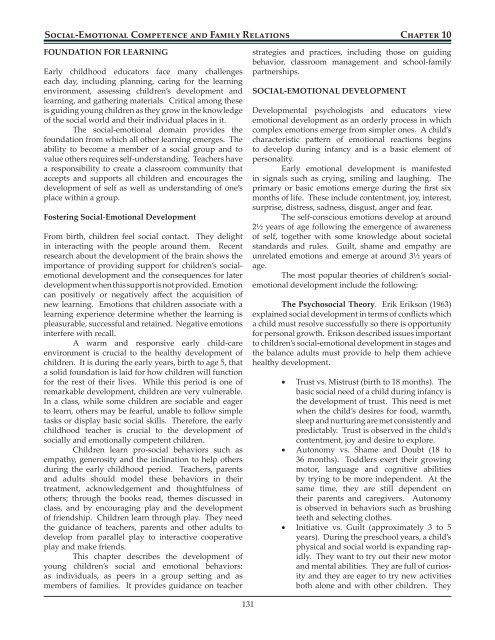Early Childhood - Connecticut State Department of Education
Early Childhood - Connecticut State Department of Education
Early Childhood - Connecticut State Department of Education
Create successful ePaper yourself
Turn your PDF publications into a flip-book with our unique Google optimized e-Paper software.
Social-Emotional Competence and Family Relations Chapter 10<br />
FOUNDATION FOR LEARNING<br />
<strong>Early</strong> childhood educators face many challenges<br />
each day, including planning, caring for the learning<br />
environment, assessing children’s development and<br />
learning, and gathering materials. Critical among these<br />
is guiding young children as they grow in the knowledge<br />
<strong>of</strong> the social world and their individual places in it.<br />
The social-emotional domain provides the<br />
foundation from which all other learning emerges. The<br />
ability to become a member <strong>of</strong> a social group and to<br />
value others requires self-understanding. Teachers have<br />
a responsibility to create a classroom community that<br />
accepts and supports all children and encourages the<br />
development <strong>of</strong> self as well as understanding <strong>of</strong> one’s<br />
place within a group.<br />
Fostering Social-Emotional Development<br />
From birth, children feel social contact. They delight<br />
in interacting with the people around them. Recent<br />
research about the development <strong>of</strong> the brain shows the<br />
importance <strong>of</strong> providing support for children’s socialemotional<br />
development and the consequences for later<br />
development when this support is not provided. Emotion<br />
can positively or negatively affect the acquisition <strong>of</strong><br />
new learning. Emotions that children associate with a<br />
learning experience determine whether the learning is<br />
pleasurable, successful and retained. Negative emotions<br />
interfere with recall.<br />
A warm and responsive early child-care<br />
environment is crucial to the healthy development <strong>of</strong><br />
children. It is during the early years, birth to age 5, that<br />
a solid foundation is laid for how children will function<br />
for the rest <strong>of</strong> their lives. While this period is one <strong>of</strong><br />
remarkable development, children are very vulnerable.<br />
In a class, while some children are sociable and eager<br />
to learn, others may be fearful, unable to follow simple<br />
tasks or display basic social skills. Therefore, the early<br />
childhood teacher is crucial to the development <strong>of</strong><br />
socially and emotionally competent children.<br />
Children learn pro-social behaviors such as<br />
empathy, generosity and the inclination to help others<br />
during the early childhood period. Teachers, parents<br />
and adults should model these behaviors in their<br />
treatment, acknowledgement and thoughtfulness <strong>of</strong><br />
others; through the books read, themes discussed in<br />
class, and by encouraging play and the development<br />
<strong>of</strong> friendship. Children learn through play. They need<br />
the guidance <strong>of</strong> teachers, parents and other adults to<br />
develop from parallel play to interactive cooperative<br />
play and make friends.<br />
This chapter describes the development <strong>of</strong><br />
young children’s social and emotional behaviors:<br />
as individuals, as peers in a group setting and as<br />
members <strong>of</strong> families. It provides guidance on teacher<br />
131<br />
strategies and practices, including those on guiding<br />
behavior, classroom management and school-family<br />
partnerships.<br />
SOCIAL-EMOTIONAL DEVELOPMENT<br />
Developmental psychologists and educators view<br />
emotional development as an orderly process in which<br />
complex emotions emerge from simpler ones. A child’s<br />
characteristic pattern <strong>of</strong> emotional reactions begins<br />
to develop during infancy and is a basic element <strong>of</strong><br />
personality.<br />
<strong>Early</strong> emotional development is manifested<br />
in signals such as crying, smiling and laughing. The<br />
primary or basic emotions emerge during the first six<br />
months <strong>of</strong> life. These include contentment, joy, interest,<br />
surprise, distress, sadness, disgust, anger and fear.<br />
The self-conscious emotions develop at around<br />
2½ years <strong>of</strong> age following the emergence <strong>of</strong> awareness<br />
<strong>of</strong> self, together with some knowledge about societal<br />
standards and rules. Guilt, shame and empathy are<br />
unrelated emotions and emerge at around 3½ years <strong>of</strong><br />
age.<br />
The most popular theories <strong>of</strong> children’s socialemotional<br />
development include the following:<br />
The Psychosocial Theory. Erik Erikson (1963)<br />
explained social development in terms <strong>of</strong> conflicts which<br />
a child must resolve successfully so there is opportunity<br />
for personal growth. Erikson described issues important<br />
to children’s social-emotional development in stages and<br />
the balance adults must provide to help them achieve<br />
healthy development.<br />
• Trust vs. Mistrust (birth to 18 months). The<br />
basic social need <strong>of</strong> a child during infancy is<br />
the development <strong>of</strong> trust. This need is met<br />
when the child’s desires for food, warmth,<br />
sleep and nurturing are met consistently and<br />
predictably. Trust is observed in the child’s<br />
contentment, joy and desire to explore.<br />
• Autonomy vs. Shame and Doubt (18 to<br />
36 months). Toddlers exert their growing<br />
motor, language and cognitive abilities<br />
by trying to be more independent. At the<br />
same time, they are still dependent on<br />
their parents and caregivers. Autonomy<br />
is observed in behaviors such as brushing<br />
teeth and selecting clothes.<br />
• Initiative vs. Guilt (approximately 3 to 5<br />
years). During the preschool years, a child’s<br />
physical and social world is expanding rapidly.<br />
They want to try out their new motor<br />
and mental abilities. They are full <strong>of</strong> curiosity<br />
and they are eager to try new activities<br />
both alone and with other children. They

















